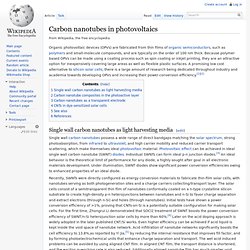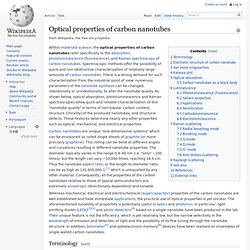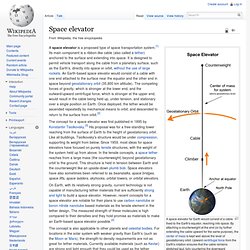

Composite Filament Winding Machine LIST 400 (ЛИСТ-400) Science Of Innovation: Smart Concrete. Unreasonable Barcelona: Erum Azeez Khan, Damascus Fortune. Carbon nanotubes in photovoltaics. Organic photovoltaic devices (OPVs) are fabricated from thin films of organic semiconductors, such as polymers and small-molecule compounds, and are typically on the order of 100 nm thick.

Because polymer based OPVs can be made using a coating process such as spin coating or inkjet printing, they are an attractive option for inexpensively covering large areas as well as flexible plastic surfaces. A promising low cost alternative to silicon solar cells, there is a large amount of research being dedicated throughout industry and academia towards developing OPVs and increasing their power conversion efficiency.[1][2] Single wall carbon nanotubes as light harvesting media[edit] Single wall carbon nanotubes possess a wide range of direct bandgaps matching the solar spectrum, strong photoabsorption, from infrared to ultraviolet, and high carrier mobility and reduced carrier transport scattering, which make themselves ideal photovoltaic material.
CNTs in dye-sensitized solar cells[edit] Optical properties of carbon nanotubes. Within materials science, the optical properties of carbon nanotubes refer specifically to the absorption, photoluminescence (fluorescence), and Raman spectroscopy of carbon nanotubes.

Spectroscopic methods offer the possibility of quick and non-destructive characterization of relatively large amounts of carbon nanotubes. There is a strong demand for such characterization from the industrial point of view: numerous parameters of the nanotube synthesis can be changed, intentionally or unintentionally, to alter the nanotube quality. As shown below, optical absorption, photoluminescence and Raman spectroscopies allow quick and reliable characterization of this "nanotube quality" in terms of non-tubular carbon content, structure (chirality) of the produced nanotubes, and structural defects. Those features determine nearly any other properties such as optical, mechanical, and electrical properties. Terminology[edit] This article uses the following abbreviations: Armchair nanotube. Technology%20Insight%20Report-%20Carbon%20Nanotubes. First all-carbon solar cell made from nanotubes and buckyballs.
Part of the reason that solar cells aren't on top of every roof everywhere harvesting energy is that they're expensive, and part of the reason that solar cells are expensive is because they're made with exotic elements like indium.

How about, let's instead make them with one of the top five most common elements in the entire Universe: say hello to the all-carbon solar cell. Carbon can be as black as coal or as clear as diamond, and by getting creative, you can harness its strength on a much smaller scale with round carbon buckyballs and long and skinny carbon nanotubes. By getting even more creative, researchers at Stanford have managed to transform different sorts of carbon into all of the pieces you need to create a fully functional solar cell. A solar cell consists of a bottom electrode, a top electrode, and something in the middle that a sucks up photons and turns them into electrons.
And now, what you've all be waiting for: the downside! Stanford, via Futurity. Space elevator. A space elevator for Earth would consist of a cable fixed to the Earth's equator, reaching into space.

By attaching a counterweight at the end (or by further extending the cable upward for the same purpose), the center of mass is kept well above the level of geostationary orbit. Upward centrifugal force from the Earth's rotation ensures that the cable remains stretched taut, fully countering the downward gravitational pull. Once above the geostationary level, climbers would have weight in the upward direction as the centrifugal force overpowers gravity. (The height relative to the diameter of the Earth on the diagram is to scale.
The height of the counterweight varies by design and a typical, workable height is shown.) A space elevator is a proposed type of space transportation system.[1] Its main component is a ribbon-like cable (also called a tether) anchored to the surface and extending into space. The concept is also applicable to other planets and celestial bodies. History where or.